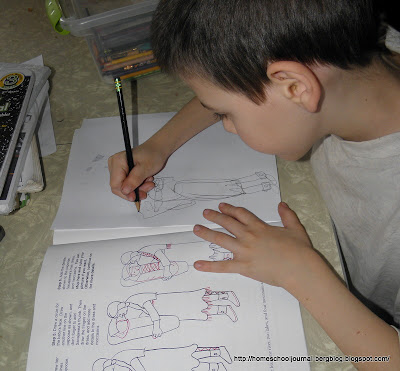The French Revolution or How We Do History
Like today's study of the French Revolution.
I began by reading to them the chapter on The French Revolution in A Child's History of the World by Hillyer. This is a wonderful book that has a voice that is very much like someone telling the story of history. It is factual, but written with an engaging style. It is written at about the 4th grade level, so it could be read by some students. It just works best for us for me to read it aloud to my youngest two boys. Despite its style, however, my boys are very visual in terms of their learning and they just need something visual to go with it or they just can't picture or understand it.
Sometimes I follow up Hillyer's book with reading from The Usborne Internet-Linked Encyclopedia of World History on the same topic. Today, however, I just left it open to the appropriate page as I read Hillyer's book and just referred to it by pointing out the pictures that went along with the sections I was reading. I showed them the storming of the Bastille as I read that section. I showed them the guillotine when the chapter talked about that, and the picture of Robespierre when we got to that point. These pictures helped to cement the story of history into their minds. You could substitute any other pairing of these type books. For example, if you have The Kingfisher History Encyclopedia, this could substitute for the Usborne volume. Even though it is written for an older audience, it still has beautiful, vivid pictures. Likewise, many people like The Story of the World by Susan Wise Bauer to substitute for Hillyer's book. The Story of Mankind by Hendrik Willem Van Loon (updated 1999 edition) is also a nice choice, and one I like to use for our second round of our 4-5 year history plan. (My high schoolers are using the Kingfisher and Van Loon's book now.)
 |
| inside the The Usborne Internet-Linked Encyclopedia of World History |
We always take time to talk about it after the reading and looking at pictures. Sometimes I prompt them with questions, sometimes they have questions of their own that I or a book can clarify, sometimes we just talk about it...whatever comes to mind. Often it is our thoughts about what it would have been like to have been there at that time. How would we have felt? What would we have done? My seven-year old is at the stage where he wants to categorize people into the "good guys" and the "bad guys." We often discuss that people are people in different circumstances, and we all have a tendency to do things we shouldn't under difficult circumstances. I do want to instill into their minds and hearts that there are heroes with qualities that we can try to copy, and there are people that have qualities that we do not want to copy, but at the same time I want to encourage them away from stereotyping and being too judgmental. These discussions help with these issues. In today's discussion, we talked about how the French were influenced by the American Revolution. We always do American History in context of World History and not at a separate time. It seems to have so much of a richer meaning when we can see how what we are doing in America is affected by what is happening in other countries and also how we, as a country, have affected other countries. It gives history a much richer tapestry. Before our break, we had studied the American Revolution for a few weeks, and coming back this week, we began with the French Revolution, and so we made simple connections between the two. We even read a bit of each of the Declarations of Independence (France: Declaration of the Rights of Man) and compared them. Not too much, but just a little, is a perfect amount for a 2nd and a 4th grader.
 |
| Student drawing Sacajawea from Draw and Write Through History. |
"Children have other ways of expressing the conceptions that fill them when they are duly fed. They play at history lessons, dress up, make tableaux, act scenes; or they have a stage, and their dolls act, while they paint the scenery and speak the speeches. There is no end to the modes of expression children find when there is anything in them to express."Charlotte Mason, Homeschooling Series, Vol 1., p. 295
For today's lesson on the French Revolution, we didn't come up with any projects, and that is okay too. We laughed about the idea of having a guillotine model just like they have the trebuchet models. It is not necessary to do a project with each and every lesson, for then it becomes drudgery in itself, and that is just what we are avoiding.
My high schoolers are running along side us in their history, with much deeper concepts and connections, of course, but when we are all on a similar course, we can each add to dinner time discussions to our own level and perhaps we will sometimes go over our little ones' heads from time to time, I am more often surprised by their insights. They are absorbing much more than I ever thought possible.
What are some of the ways you teach and learn about history?



